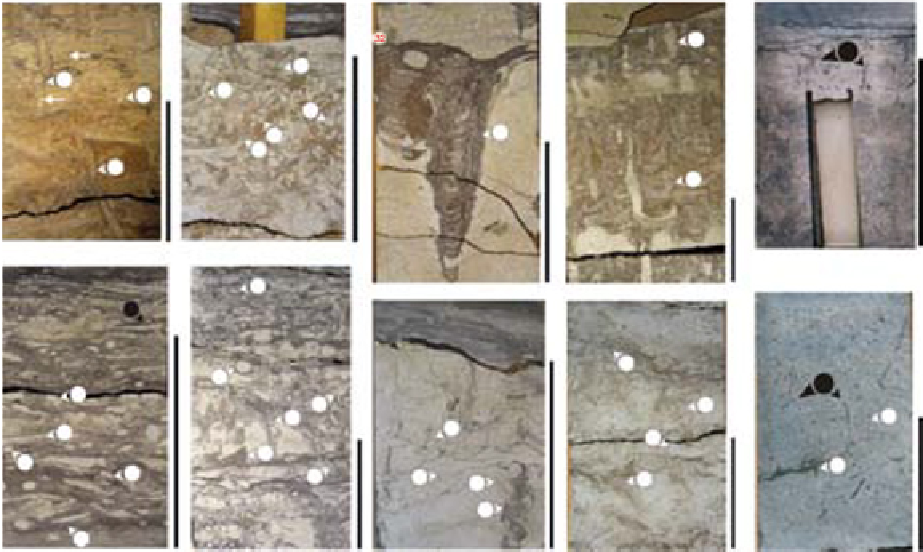Geoscience Reference
In-Depth Information
(I)
(A)
(B)
(C)
(D)
D
rt
D
D
Cy
P
Te
D
Th
Pa
Ro
D
(E)
(F)
Pa
(J)
(G)
sy
(H)
P
Th
rt
Pa
Ro
Cy
Sk
D
Th
Th
Th
Po
P
Sk
Te
Cy
S
Ro
Cy
D
Ch
Fig. 8.
Intensely bioturbated sandstones in the Smørbukk field. Scale bar (right side of the core photos) is 10 cm long.
Reddish bioturbated sandstone (Facies 6.1): (A) Intensely bioturbated (BI 5), homogeneous, reddish fine-grained to
medium-grained sandstone showing dispersed sub-angular calcite grains (white arrows). Trace fossils include
Diplocraterion
(
D
),
Rosselia
(
Ro
) and rare
Planolites
(
P
); (B) Completely bioturbated (BI 5-6) fine-grained sandstone showing elements of
the
Skolithos
and
Cruziana
ichnofacies: the assemblage consists of
Diplocraterion
(
D
),
Cylindrichnus
(
Cy
),
Thalassinoides
(
Th
),
Teichichnus
(
Te
) and
Palaeophycus
(
Pa
). Disturbed sandstone (Facies 6.2): (C) Fine-grained to medium-grained sand-
stone showing large-scale
Diplocraterion
(
D
); (D) Fine-grained disturbed sandstone showing multiple U-shaped
Diplocraterion
(
D
) burrows cross-cutting each other. Disturbed heterolithics (Facies 6.3): (E) Mudstone-dominated dis-
turbed heterolithics, showing syneresis cracks (sy) and abundant bioturbation (BI 5) mainly composed of
Chondrites
(
Ch
),
Planolites
(
P
),
Palaeophycus
(
Pa
),
Teichichnus
(
Te
) and rare
Thalassinoides
(
Th
); (F) Mixed sandstone/mudstone hetero-
lithics showing abundant and diverse bioturbation composed of
Palaeophycus
(
Pa
),
Diplocraterion
(
D
),
Thalassinoides
(
Th
),
Cylindrichnus
(
Cy
),
Rosselia
(
Ro
) and rare
Phoebichnus
(
Po
). Light grey homogenised sandstone (Facies 6.4): (G) Very
fine-grained sandstone showing complete bioturbation (BI 6); overlapping trace fossils consist mainly of
Thalassinoides
(
Th
),
Diplocraterion
(
D
),
Cylindrichnus
(
Cy
) and
Skolithos
(
Sk
). Rooted sandstone (Facies 6.5): (I) Very fine-grained sand-
stone showing plant roots (rt) with bifurcated ending and 'mottled' aspect of the lower intervals; (J) Intensely bioturbated
silty sandstone showing small plant roots (rt) and
Skolithos
(
Sk
).
recognisable sedimentary structures (parallel
lamination, syneresis cracks and ripple cross-
lamination) occurring in subfacies 6.3 suggest
an association with the mixed sandstone: mud-
stone wavy-bedded current-dominated deposits
(Facies 5.2.2) and the lenticularly-bedded
current-dominated heterolithics (Facies 5.3.2).
The preserved sedimentary structures suggest
relatively slow currents. The trace-fossil
suite (
Planolites, Palaeophycus, Chondrites
,
Rhyzocoralium
,
Dip locraterion
,
Cylindrichnus
,
Rosselia
,
Teichichnus
and rare
Thalassinoides
and
Phoebichnus
) suggest shallow to mid-tier
deposit-feeding and suspension-feeding com-
munities in a moderate-energy setting that was
subjected to temporal changes in salinity, sedi-
mentation rates/turbidity and oxygenation.
Subfacies 6.4: Light grey homogenised sandstone
The very fine to fine-grained light grey sand-
stone (up to 30 cm thick) that comprise this subfa-
cies shows abundant to complete bioturbation
by a high-diversity mixed
Cruziana-Skolithos
suite (Figs 8G & 8H). The trace-fossil elements
(
Palaeophycus
,
Planolites
,
Cylindrichnus
,
Rosselia
,
Skolithos
,
Thalassinoides, Ophiomorpha
and less
common
Diplocraterion
and
Rhizocorallium
) repre-
sent a proximal
Cruziana
Ichnofacies (MacEachern
& Bann, 2008). The intensity and diversity of the

Search WWH ::

Custom Search